Following on from last year’s Meridian straight line travelogue, I came across an interesting cycle route on another route planning platform (includes the letter K, but the route is on open display on the internet). This is the “Netherlands Giant Circle”: approximating the biggest circle that fits within the borders of the country, and this seemed like a good way to see different parts of the Netherlands and go to some previously-unvisited towns.
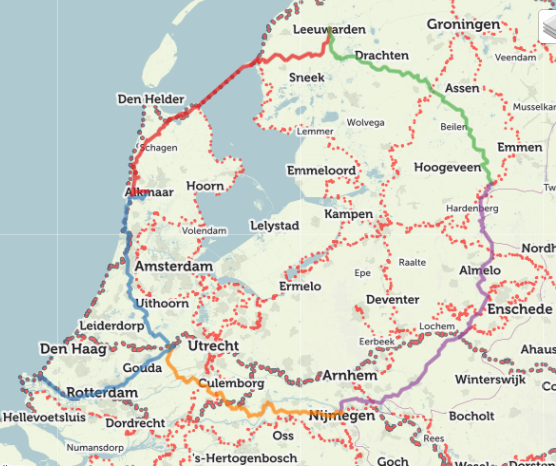
First, the prologue. This time I opted to use the ferry from Harwich to Hoek van Holland, and I found the check-in, boarding and disembarkation much more pleasant than the frantic procedure at Dover Eastern Docks (the latter’s disappearing red line for cyclists being particularly unhelpful). At Hoek van Holland it is only 450 metres from the ship to the RET Rotterdam area metro, bicycles allowed after 09:00, tap-on tap-off with a debit card for the Lijn B journey to Rotterdam Alexander, then a NS train to Woerden and the start of the circle ride.
Day 1: Woerden to Alkmaar. Soon out of the town and into open countryside. This is Het Groene Hart van Holland, the green heart of the southern part of the Netherlands, with lush green fields interleaved with a grid of drainage ditches. Although it was not remotely like the Dutch Headwind Cycling championships (NK Tegenwindfietsen), it was still steady work into the prevailing wind. Onwards through Haarlem to the Nordzeekanaal ferry (free for cyclists, of which there were many). This was the first of eight ferry crossings of varying sizes on this tour. From there into the dune reserve (Noordhollands Duinreservaat), the herringbone brick cycle path weaving among the steep dune and heathland landscape, then turning off to head into Alkmaar for the overnight stop.
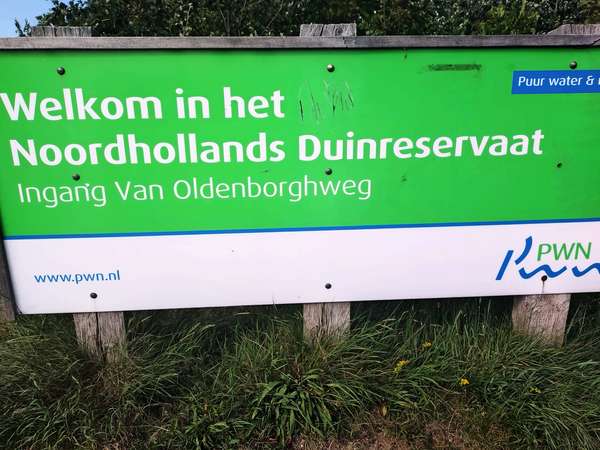
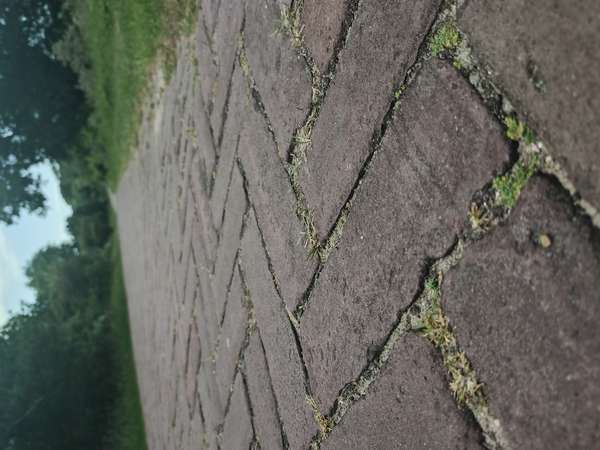
Day 2: Alkmaar to Leeuwarden. Back towards the coast and continuing in the dune reserve, this part more forested, then emerging into flat farmland at Groet, followed shortly by a bonus ferry crossing near Burgerbrug as the small bridge was under repair.
Onward to Den Oever, but here things went wrong. The borrowed Giant Circle route (and cycle.travel) indicated that you could ride over the Afsluitdijk causeway, but as I write (July 2025) you can’t. Massive disappointment: I was looking forward to riding 30 kilometres with a tailwind. At the point where the cycle path should start along the causeway there was a padlocked gate with an entry prohibited sign. A local man called out as I stood looking puzzled, and explained that the path had been “closed for years” but there is a bus. He was indeed correct: after-the-fact internet research shows that most of the Afsluitdijk cycle path has been closed since 1 April 2019 as the dyke is raised and improvements made to the sluices (the Dutch Cyclists' Union thought it might be an April Fool joke, but no). Although car traffic continues, the bike path is not scheduled to re-open until October 2025 at the earliest. Turning back, I saw rather obvious signs that I had ridden past, eventually found the bus station behind the DekaMarkt car park, then had a wait for the hourly bike bus to arrive. See: https://theafsluitdijk.com/bicycle-bus-timetable/
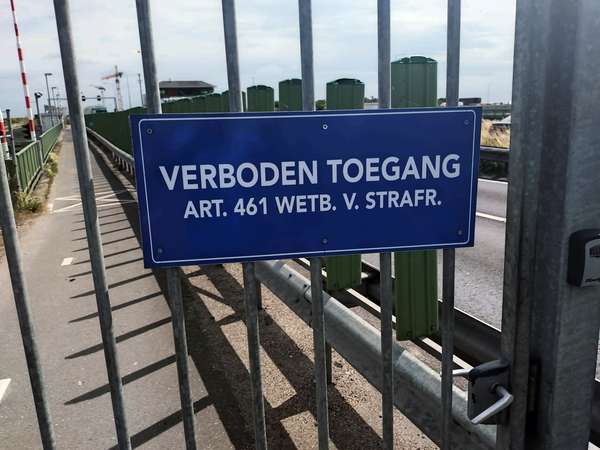
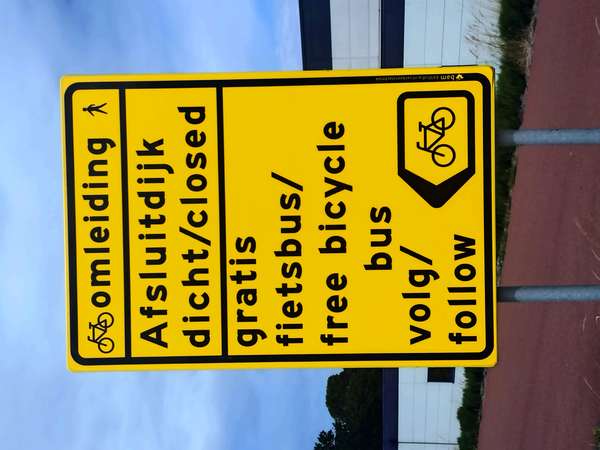

The bus drops off at the Kornwerderzand island, so I did get a short tailwind-assisted ride (40 km/h) along part of the causeway before turning east and zig-zagging across the windy but lush green Fryslân farmland, many village signs (e.g. Cornwerd/Koarnwert) in both Dutch and Frisian. After Easterwierrum turning north into Leeuwarden for the overnight stop, with a quick walk to find the statue of Margaretha Geertruida Zelle, also known as Mata Hari.
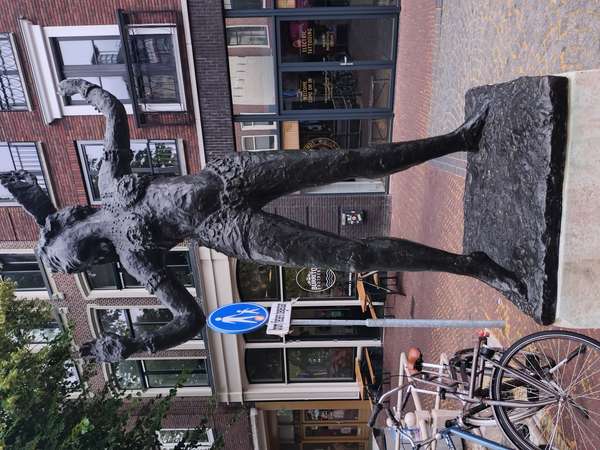
I really should have done more research before coming to this area, as further Wikipedia reading revealed my ignorance of the multiple dialects in different parts of Friesland (and the Netherlands), this also leading me to the wonderful Wikitongues website, www.wikitongues.org, with videos of volunteers speaking Dutch, Frisian, and Bildts.
Day 3: Leeuwarden to Coevorden. South out of Leeuwarden towards Grou to return to the Giant Circle, and turning east to enter De Alde Feanan, one of the Netherlands twelve national parks. Crossing into the park and onto De Burd island was on the first of the day’s three small ferries (pontjes), this one carrying me and one car, the ferryman advising me that they were working on the “klok” (engine) of the next ferry and hoped it would be ready to start operating at 10:00. Riding on a little further I reached that ferry: the wonderfully-named Pont de Snoekcbears which shuttles the short distance across De Greft canal, and the engineer was indeed working below deck with three volunteer ferrymen cheerfully chatting nearby. I had a half-hour wait but the ferry was ready on schedule, and it gave time to sit and watch the activity on the adjacent lake Sitebuorster Ie: motor yachts, canoes, sail boarding, and many sailing boats including a glimpse of one example of a traditional Frisian skûtsje with its fan-shaped leeboards (pivoting keels). Larger skûtsje flat-bottomed sailing barges were once the main form of cargo transport in the shallow waters of inland lakes and canals, but smaller ones are now for skilled recreational activity.
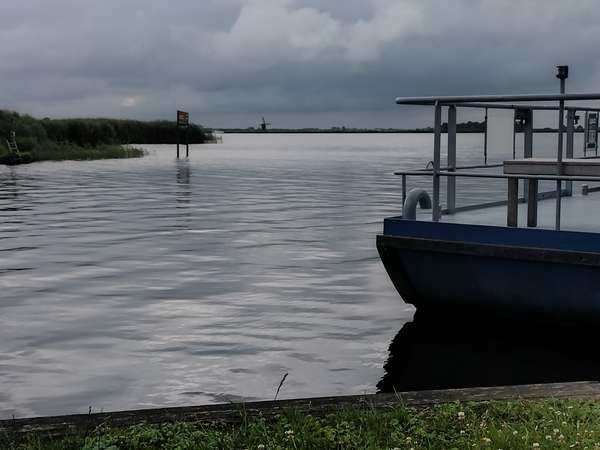
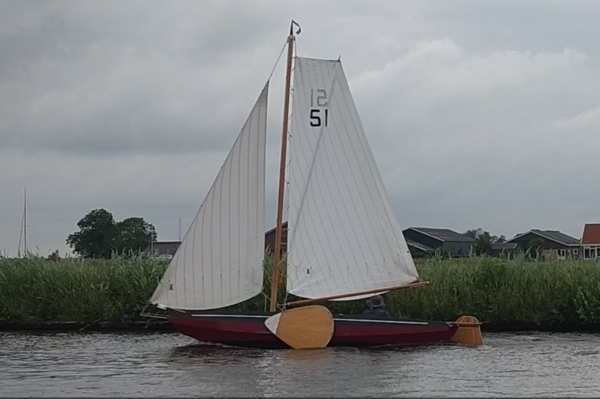
Continuing and across De Grietman ferry (there is a live webcam: https://webcam-friesemeren.nl/iesicht/, so you can watch the crossing from your laptop), then to Beetsterzwaag/Beetstersweach and a stop for coffee and cake. Onward along quiet lanes among more wooded farmland, and into Drenthe province and Fochteloërveen where the cycle path runs through marshy heathland, white storks stalking alongside a drainage ditch where the farmer was raking weed up onto the bank, presumably hopeful of feeding on disturbed frogs. Finally into Coevorden for the overnight stop.
Day 4: Coevorden to Nijmegen. This was the longest day, and it unfortunately started with heavy rain for the first two hours, remaining overcast and windy all day. Grateful to stop for an early coffee at Gramsbergen to allow the rain to ease, before continuing south in more wooded countryside. Eventually up a very slight climb to Needse Berg (all of 36 metres above sea level) where there is a wooden viewing tower. Through Borculo and into woodland, stopping for lunch at the small farm museum at Lebbenbrugge. Onward through Doetinchem, where there was once a large Vredestein bicycle tyre factory, across the Pannerdensch Kanaal via a busy ferry, and into the centre of Nijmegen on the excellent bicycle superhighway, parking my bike overnight in the Fietstransferium underneath Nijmegen railway station as my city centre hotel had nowhere to store a bike.
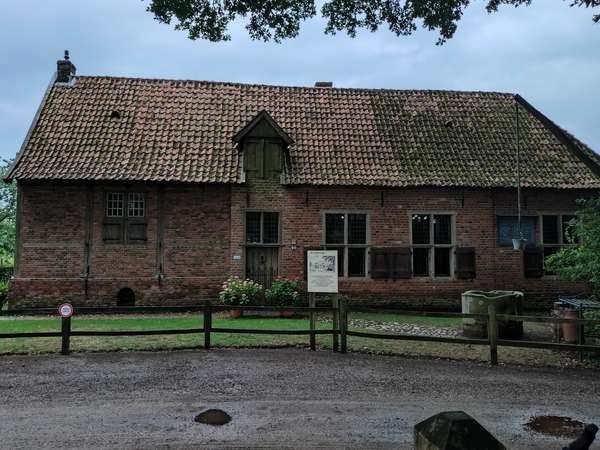
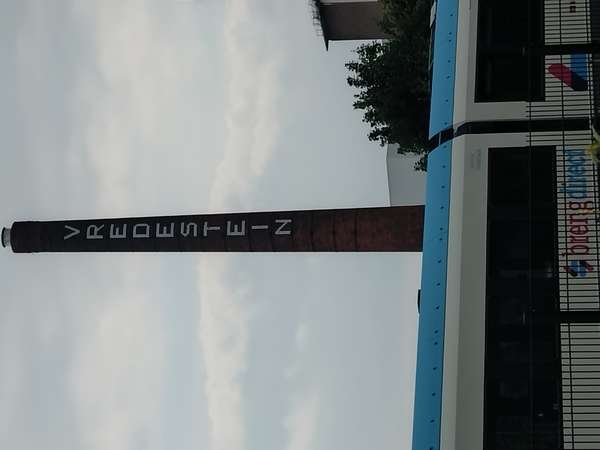
Day 5: Nijmegen to Woerden. First to the Waal riverside to visit Velorama: originally the private collection of Gertjan Moed, now the Dutch national cycle museum with a superb collection of very early bicycles, as well as the bicycle ridden in 1951 by Willem van Est (1923-2003), the first Dutch rider to wear the yellow jersey in the Tour de France, but who fell 70 metres down a ravine on the descent of the Col d’Aubisque. He raced the Tour again in 1952-1955, winning three stages. The attic space of Velorama contains a reconstruction of an old workshop.
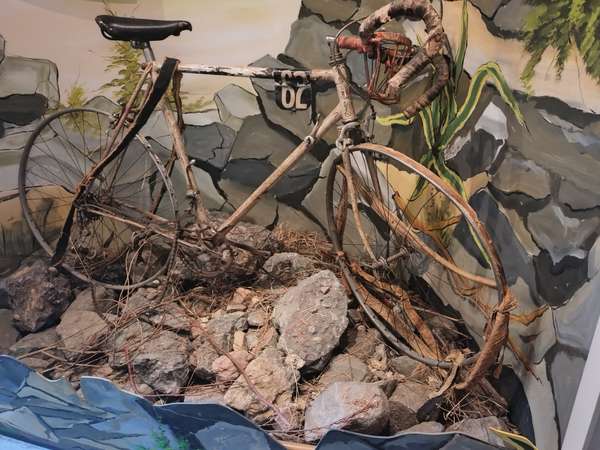
Onwards out of Nijmegen, then riding past the De Groene Heuvels park near to Bergharen that was a hive of activity setting up a huge covered stage with associated temporary buildings and campsites for Down the Rabbit Hole (DTRH), a Glastonbury-style music festival which was to take place on 4-6 July. Across the Waal on the Tiel-Wamel ferry, then stop for lunch at Twins diner. Continuing in farmland, here with extensive fruit orchards, then the last of the ferry crossings, this one over the river Lek at Ameide-Lopik, and back across flat grassland with a strong cross-headwind back to Woerden to complete the Giant Circle.
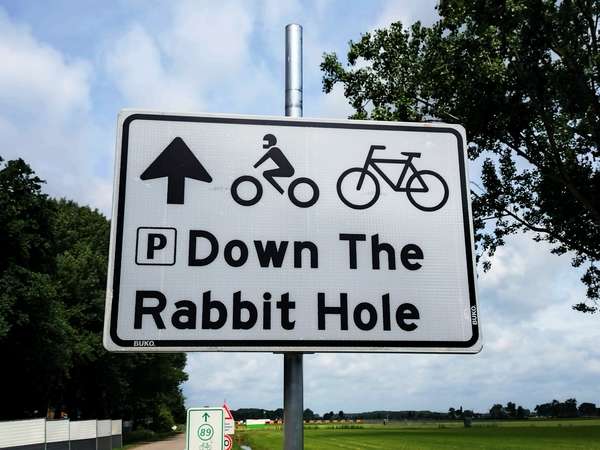
Day 6: Woerden to Hoek van Holland. A morning stroll around the island that forms the centre of Woerden, and I was hoping to see the cheese market that the internet suggested took place every Saturday morning. There were plenty of market stalls, but no Kaasmarkt, instead there was the superbly-stocked van Bemmel kaashandel.
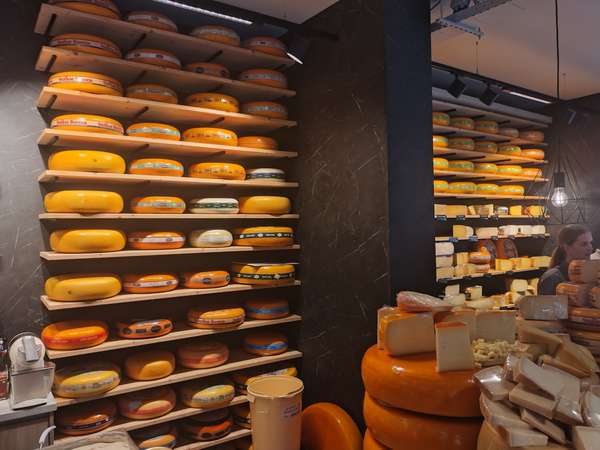
Out of Woerden across the grassland neatly divided with drainage channels, and the busy cycle path winding among the lakes of Reeuwijke Plassen, then into the centre of Gouda, many market stalls in the area around Sint-Janskerk. Continuing alongside the Ijssel to the outskirts of Rotterdam, and a magnificent succession of cycle paths. Occasionally motor traffic had priority with bicycles controlled by dedicated lights, the circle of white LEDs counting down to the green, and it was noticeable how well this was obeyed, in contrast to riding through London where red traffic lights are routinely ignored by e-bike riders - UK cyclists don't help ourselves with this behaviour.
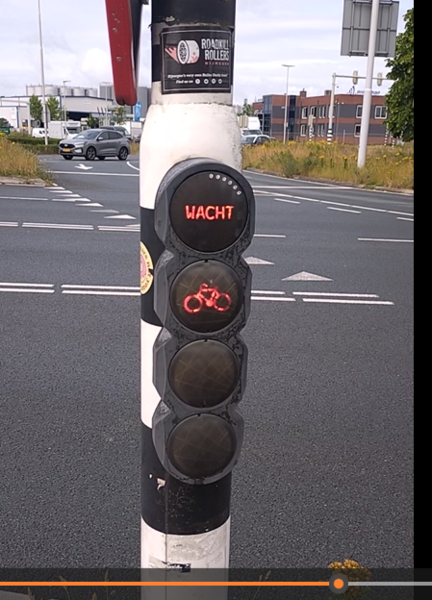
Stop for lunch at De Eekhorn at the edge of Kralingse Bos, then onward past Rotterdam Centraal station and after Maasluis riding alongside the river towards the ferry terminal. Too early for the ferry, so I diverted into the centre of Hoek van Holland, before a superbly efficient check in and boarding, followed by the smooth crossing back to Harwich. The following morning, I rode to Manningtree to catch the train and (sigh) saw the first pot-hole since travelling to the Netherlands.
Right, I think that’s enough of the geometrical cycle.travelling.
Oh, I nearly forgot to continue the running joke, but here is a photograph of a potato field somewhere near Burgerbrug. Membership of the fan club remains disappointingly low (OK, zero). The variety on the right have white flowers, while a different variety on the left had yet to come into bloom. Some on the same farm had pale blue or purple flowers, but I couldn’t get them in the same picture.




